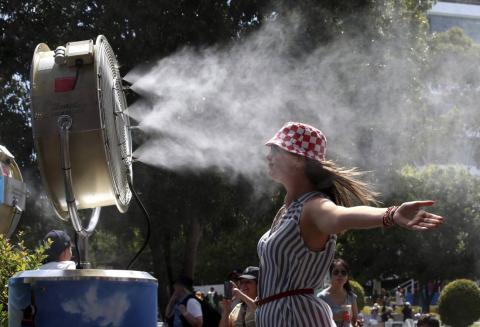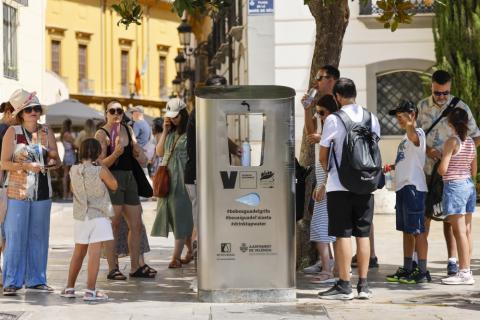Many regions of Spain will experience unusually warm weather for this time of year
The State Meteorological Agency (AEMET) has reported that a warm weather will bring temperatures 6 to 7 ºC higher than normal for this time of year throughout Spain. According to AEMET, 29 May to 1 June could be the warmest days for this time of year since at least 1950.

Julio y Cristina - calor mayo EN
Cristina Linares
Senior scientist at the Carlos III Health Institute
Julio Díaz
Research professor and co-director of the Reference Unit on Climate Change, Health and the Urban Environment at the Carlos III Health Institute
Indeed, as AEMET rightly points out, this is an episode of abnormally high temperatures for this time of year and, although it is forecast to be short-lived (until the weekend), in some geographical areas the threshold temperature for a heatwave is expected to be exceeded from a health risk perspective. This means that there may be significant health impacts on particularly vulnerable groups such as the elderly, people with pre-existing conditions (cardiorespiratory, neurological, renal, etc.), people taking multiple medications, dependent people, people on low incomes, pregnant women, children and people who work intensively outdoors during the middle of the day.
As this is the first heatwave of the year, there may be a greater number of susceptible people whose pre-existing conditions may be aggravated. Furthermore, as this heatwave is mainly caused by the arrival of a mass of air from Africa, it is very likely that atmospheric concentrations of particulate matter (PM10) will also increase. Furthermore, in these situations, other pollutants such as NO2 (nitrogen dioxide) and O3 (ozone) could also increase their concentrations in the air, especially in urban areas. This means that the health impacts associated with high temperatures are compounded by those derived from pollution, which in some cases can have a greater effect on health in the short term than those derived from the thermal anomaly itself.
Rubén del Campo - calor mayo EN
Rubén del Campo
Spokesperson of the State Meteorological Agency (AEMET)
Is it normal to see these temperatures at this time of year?
"This is a very warm spell, unusual for this time of year. Maximum temperatures will be between 5 and 10ºC above normal across practically the entire peninsula from Tuesday 27th to Sunday 1st, and in some areas in the north, east and south, more than 10ºC above normal. This is typical of the dog days of summer, the hottest period of the year (usually the second half of July and the first half of August).
An analysis of the air masses that will affect us over the next few days (taking into account the forecast temperature at an altitude of 1,500 metres, to reduce the influence of local factors) reveals that, at certain times and in certain areas, it will be warmer than any of the episodes that have affected Spain between the end of May and the beginning of June between 1990 and 2020, the reference period. In addition, 29 May to 1 June could be the warmest days for those specific dates across the entire peninsula since at least 1950.
And is it normal for it to affect so many areas of Spain?
‘The episode is characterised both by its intensity for the end of May and by its extent, as temperatures will be very high for the time of year in practically the whole of the peninsula from Tuesday to Sunday. The Balearic and Canary Islands will also have higher than usual temperatures during the weekend, although to a lesser extent. It is therefore a very extensive episode’.
What recommendations would you make to the population, which only a few days ago was experiencing cooler than normal temperatures?
Although in absolute terms it is not an episode of extreme heat, as these are temperatures that can usually be reached in the middle of summer, it must be taken into account that this is an early situation, with spring not yet over, and in this sense, the body is receiving the heat without prior acclimatisation and after a first fortnight of May that was cooler than normal. In this regard, it is advisable to protect yourself from the heat, avoid intense physical exercise during the middle of the day and, above all, keep an eye on elderly people and those with pre-existing conditions to prevent dehydration or possible heatstroke".
José Miguel Viñas - calor mayo EN
José Miguel Viñas
Meteorologist at Meteored at www.tiempo.com and consultant for the WMO (Spain)
Is it normal to see these temperatures at this time of year?
"These are not normal temperatures (those corresponding to the average daily extremes dictated by the climate), but we are moving towards a new normal in which these episodes of intense heat outside the summer period, both in spring and autumn, are becoming more likely. Apart from its exceptional nature, the heatwave we are experiencing is also striking because it comes at the end of a spring in which we have had below-average temperatures for much of the season, which has been accompanied by a weather pattern that is also unusual due to its persistence."
And is it normal for it to affect so many areas of Spain?
"From a meteorological point of view, the current situation is no different from what usually occurs in the middle of a heatwave, which is, climatologically speaking, the period of highest temperatures of the year. The ridge of warm air that has settled over the peninsula and the Balearic Islands extends over much of the territory, which is why the rise in temperatures is widespread, with the heat extending over most of Spain. From Thursday onwards, the high temperatures will be accompanied by haze. Saharan dust will move in from the south of the peninsula, clouding the skies over the entire Atlantic coast. The greatest haze is expected across the south-west of the peninsula, Ceuta and Melilla. The presence of haze will lead to a string of warm or tropical nights (with minimum temperatures not falling below 20 °C) in the centre-south-east of the peninsula and in the Balearic Islands.
What recommendations would you make to the population, which only a few days ago was experiencing colder than normal temperatures?
"The recommendations are not very different from those given in summer when we have a similar heatwave or even a heatwave. We have the advantage that our homes are still cool, although they will gradually warm up as the week progresses. It is important to try to keep our homes cool by opening and closing windows and blinds at the right times of day.
Another factor to bear in mind is that, unlike in summer, we are still in the school year, so we need to protect pupils (especially the youngest ones) and teaching staff as best we can, both while they are at school (adequate ventilation in classrooms, hydration, etc.) and when they leave, which is when the sun is at its strongest.
We will increasingly face this type of situation, to which we will have to adapt quickly in order to reduce the impact of extreme heat on us.
Dominic Royé - calor mayo EN
Dominic Royé
Researcher at the Galician Biological Mission – CSIC
Is it normal to record these temperatures at this time of year?
"The extreme events we are seeing are not only becoming more frequent and intense, but are even arriving earlier than normal. This episode is not normal when we see anomalies of up to 10 degrees above average temperatures for this time of year, especially when we look at the maximum temperatures of 40ºC; these are temperatures typical of July, in the middle of summer. We are also seeing that the intermediate seasons (spring and autumn) are becoming shorter and the change is more sudden and abrupt.‘
And is it normal for it to affect so many areas of Spain?
’It is a combination of a mass of warm air from North Africa and a persistent anticyclone that is blocking the entry of cooler air. It is a synoptic-scale situation, so it can affect a large part of the peninsula. However, it is not only the warm air from Africa, but also the peninsula itself, which facilitates the warming of the air descending from higher layers (air descending in the centre of the anticyclone is compressed and heated adiabatically).
What recommendations would you make to the population, which only a few days ago was experiencing cooler than normal temperatures?
‘We know that the first heatwave and the first days of extreme heat carry a higher risk of mortality, due to a lack of seasonal acclimatisation. Therefore, vulnerable groups (the elderly, children, people with medical conditions) should stay informed, review and adapt their habits, reduce sudden exposure to high temperatures and anticipate changes.’



